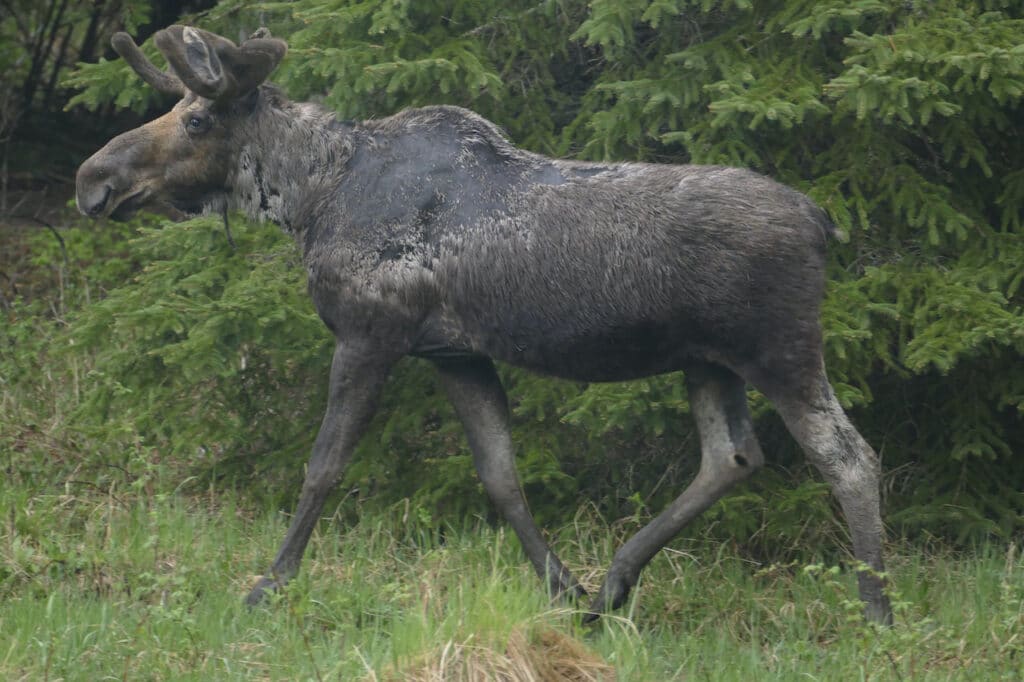
A new study indicates that climate change could worsen a serious problem for moose: winter ticks. Nineteen years of research on Isle Royale shows that the parasites are usually much more abundant on moose during winters that follow warm summers. In high enough numbers, the ticks can leave a moose anemic, its coat in tatters, and less likely to reproduce. They can also make it harder for calves to survive to adulthood.
The scientists recently published their findings in the peer-reviewed journal Frontiers in Ecology and Evolution. They performed their analysis by photographing moose in side profile, and developing methods to measure how many ticks they were carrying at a crucial time of the year. An individual moose can regularly host tens of thousands in one winter.
“[Warmer] summer temperatures were associated with higher tick burdens the following spring, as indicated by hair loss, with July temperatures explaining nearly half the interannual variation in hair loss,” the study authors wrote.
The team included four scientists from Michigan Technological University in Houghton, Mich., including lead author Sarah Hoy, Leah Vucetich, who conducted all the image processing, John Vucetich, who contributed in several ways, and Rolf Peterson, who has decades experience studying Isle Royale’s wolves and moose.
Closely linked lives
Moose are particularly prone to winter ticks because they have the least history with the pests. Moose are believed to have only arrived in North America about 20,000 years ago, and they don’t groom themselves to reduce tick numbers like deer, elk, and other species favored by the insects.
The reasons warm summers benefit ticks at the expense of moose is connected to both species’ annual life cycles. Female winter ticks lay several thousand eggs near the soil surface in June, which hatch in August and September. Warmer summers help the eggs develop faster and increases survival rates.
That fall, the larvae climb vegetation and seek an ungulate, like a deer or moose, until the first extended freeze. If they don’t find a host before winter, they die. Warmer autumns can extend their window of opportunity.
The larvae then feed, molt into nymphs, and go dormant until late January. They feed again, morph into adults, and then have a final meal before dropping off the animal in late April. When they drop off, they rarely survive if they land on snow-covered ground. Global warming could increase the chances they find bare ground and the females manage to lay eggs.
The study does not specifically point to impacts already caused by climate change, because summers in the Great Lakes region have not increased in temperature very much yet due to global warming, with most warming occurring in winter so far. The two-decade study spanned cooler and warmer summers in current climate cycles.
Summer warming just starting
But it does offer a warning, because climatologists expect warm summers to become much more common in the decades head. Global warming is already to blame for rapidly increasing winter average temperatures in the region, which stress moose in several ways, and as summers start to follow, ticks could be a greater threat.
“If such temperature increases occur, then our results suggest that average hair loss may regularly exceed 50–60% which is indicative of severe tick burdens for moose,” the paper reads. “The ramifications of any such climate related changes in parasite dynamics are likely to be substantial and widespread given that parasites play an important role in shaping the composition, structure, productivity and stability of communities and ecosystems.”
Studies have shown that summers in the Great Lakes region are expected to warm by a minimum of about 3.5 degrees Fahrenheit, and as much as 7 to 14 degrees, in the next 80 years. In New England, one of the few places where summers are rapidly warming, moose are being significantly harmed by winter ticks.
“There are growing concerns about how climate change will modify host-parasite interactions,” the authors write. “For example, new host-parasite relationships seem likely to form as species shift their geographic ranges in response to climate change and some host species will be exposed to parasites to which they have no immunity or coevolutionary history.”
The moose of Isle Royale present a number of unique variables that means the study’s insights may be limited in how it applies elsewhere. On Isle Royale, there is no hunting, wolves are the only predators, and there are no other hosts of winter ticks, such as white-tailed deer. There is also no logging to affect forest types. These factors all affect the impact of ticks.
For example, the researchers speculate that when predator numbers are high, moose may seek habitat where they are safer from wolves, but more prone to being parasitized by ticks. This idea is based on the observation that tick numbers were higher on moose when there were a relatively high number of wolves around.
References:
Hoy SR, Vucetich LM, Peterson RO and Vucetich JA (2021) Winter Tick Burdens for Moose Are Positively Associated With Warmer Summers and Higher Predation Rates. Front. Ecol. Evol. 9:758374. doi: 10.3389/fevo.2021.758374

